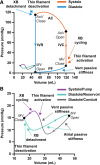Fine tuning contractility: atrial sarcomere function in health and disease
- PMID: 38156887
- PMCID: PMC11221815
- DOI: 10.1152/ajpheart.00252.2023
Fine tuning contractility: atrial sarcomere function in health and disease
Abstract
The molecular mechanisms of sarcomere proteins underlie the contractile function of the heart. Although our understanding of the sarcomere has grown tremendously, the focus has been on ventricular sarcomere isoforms due to the critical role of the ventricle in health and disease. However, atrial-specific or -enriched myofilament protein isoforms, as well as isoforms that become expressed in disease, provide insight into ways this complex molecular machine is fine-tuned. Here, we explore how atrial-enriched sarcomere protein composition modulates contractile function to fulfill the physiological requirements of atrial function. We review how atrial dysfunction negatively affects the ventricle and the many cardiovascular diseases that have atrial dysfunction as a comorbidity. We also cover the pathophysiology of mutations in atrial-enriched contractile proteins and how they can cause primary atrial myopathies. Finally, we explore what is known about contractile function in various forms of atrial fibrillation. The differences in atrial function in health and disease underscore the importance of better studying atrial contractility, especially as therapeutics currently in development to modulate cardiac contractility may have different effects on atrial sarcomere function.
Keywords: atria; cardiomyopathy; contractility; myofilament; sarcomere.
Conflict of interest statement
No conflicts of interest, financial or otherwise, are declared by the authors.
Figures



Similar articles
-
Alpha and beta myosin isoforms and human atrial and ventricular contraction.Cell Mol Life Sci. 2021 Dec;78(23):7309-7337. doi: 10.1007/s00018-021-03971-y. Epub 2021 Oct 26. Cell Mol Life Sci. 2021. PMID: 34704115 Free PMC article. Review.
-
An Exogenous NO Donor Provokes Mechanical Alternans in Normal Rat Atria and Impairs Sarcomere Contractility in Right Atrial Cardiomyocytes in Atrial Fibrillation.Biomolecules. 2025 May 17;15(5):735. doi: 10.3390/biom15050735. Biomolecules. 2025. PMID: 40427628 Free PMC article.
-
Effects of chronic atrial fibrillation on active and passive force generation in human atrial myofibrils.Circ Res. 2010 Jul 9;107(1):144-52. doi: 10.1161/CIRCRESAHA.110.220699. Epub 2010 May 13. Circ Res. 2010. PMID: 20466979
-
Cardiac Sarcomere Signaling in Health and Disease.Int J Mol Sci. 2022 Dec 19;23(24):16223. doi: 10.3390/ijms232416223. Int J Mol Sci. 2022. PMID: 36555864 Free PMC article. Review.
-
Increased thin filament activation enhances alternans in human chronic atrial fibrillation.Am J Physiol Heart Circ Physiol. 2018 Nov 1;315(5):H1453-H1462. doi: 10.1152/ajpheart.00658.2017. Epub 2018 Aug 24. Am J Physiol Heart Circ Physiol. 2018. PMID: 30141984 Free PMC article.
Cited by
-
Proteolytic degradation of atrial sarcomere proteins underlies contractile defects in atrial fibrillation.Am J Physiol Heart Circ Physiol. 2024 Aug 1;327(2):H460-H472. doi: 10.1152/ajpheart.00148.2024. Epub 2024 Jun 28. Am J Physiol Heart Circ Physiol. 2024. PMID: 38940916 Free PMC article.
-
Engineered heart tissue: Design considerations and the state of the art.Biophys Rev (Melville). 2024 Jun 20;5(2):021308. doi: 10.1063/5.0202724. eCollection 2024 Jun. Biophys Rev (Melville). 2024. PMID: 38912258 Free PMC article. Review.
-
Atrial Fibrillation Induces Sarcomere Remodeling, Enhanced Sarcomere Contractility, and Loss of Atrial Identity.Res Sq [Preprint]. 2025 Apr 23:rs.3.rs-6422874. doi: 10.21203/rs.3.rs-6422874/v1. Res Sq. 2025. PMID: 40313766 Free PMC article. Preprint.
References
-
- Olivotto I, Oreziak A, Barriales-Villa R, Abraham TP, Masri A, Garcia-Pavia P, Saberi S, Lakdawala NK, Wheeler MT, Owens A, Kubanek M, Wojakowski W, Jensen MK, Gimeno-Blanes J, Afshar K, Myers J, Hegde SM, Solomon SD, Sehnert AJ, Zhang D, Li W, Bhattacharya M, Edelberg JM, Waldman CB, Lester SJ, Wang A, Ho CY, Jacoby D; EXPLORER-HCM study Investigators. Mavacamten for treatment of symptomatic obstructive hypertrophic cardiomyopathy (EXPLORER-HCM): a randomised, double-blind, placebo-controlled, phase 3 trial. Lancet 396: 759–769, 2020. doi:10.1016/S0140-6736(20)31792-X. - DOI - PubMed
-
- Maron MS, Masri A, Choudhury L, Olivotto I, Saberi S, Wang A, Garcia-Pavia P, Lakdawala NK, Nagueh SF, Rader F, Tower-Rader A, Turer AT, Coats C, Fifer MA, Owens A, Solomon SD, Watkins H, Barriales-Villa R, Kramer CM, Wong TC, Paige SL, Heitner SB, Kupfer S, Malik FI, Meng L, Wohltman A, Abraham T; REDWOOD-HCM Steering Committee and Investigators. Phase 2 study of aficamten in patients with obstructive hypertrophic cardiomyopathy. J Am Coll Cardiol 81: 34–45, 2023. doi:10.1016/j.jacc.2022.10.020. - DOI - PubMed
-
- Kooiker KB, Mohran S, Turner KL, Ma W, Martinson A, Flint G, Qi L, Gao C, Zheng Y, McMillen TS, Mandrycky C, Mahoney-Schaefer M, Freeman JC, Costales Arenas EG, Tu AY, Irving TC, Geeves MA, Tanner BCW, Regnier M, Davis J, Moussavi-Harami F. Danicamtiv increases myosin recruitment and alters cross-bridge cycling in cardiac muscle. Circ Res 133: 430–443, 2023. doi:10.1161/CIRCRESAHA.123.322629. - DOI - PMC - PubMed
-
- Goette A, Kalman JM, Aguinaga L, Akar J, Cabrera JA, Chen SA, Chugh SS, Corradi D, D'Avila A, Dobrev D, Fenelon G, Gonzalez M, Hatem SN, Helm R, Hindricks G, Ho SY, Hoit B, Jalife J, Kim YH, Lip GY, Ma CS, Marcus GM, Murray K, Nogami A, Sanders P, Uribe W, Van Wagoner DR, Nattel S; Document Reviewers. EHRA/HRS/APHRS/SOLAECE expert consensus on atrial cardiomyopathies: definition, characterization, and clinical implication. Europace 18: 1455–1490, 2016. doi:10.1093/europace/euw161. - DOI - PMC - PubMed
-
- Litviňuková M, Talavera-López C, Maatz H, Reichart D, Worth CL, Lindberg EL, Kanda M, Polanski K, Heinig M, Lee M, Nadelmann ER, Roberts K, Tuck L, Fasouli ES, DeLaughter DM, McDonough B, Wakimoto H, Gorham JM, Samari S, Mahbubani KT, Saeb-Parsy K, Patone G, Boyle JJ, Zhang H, Zhang H, Viveiros A, Oudit GY, Bayraktar OA, Seidman JG, Seidman CE, Noseda M, Hubner N, Teichmann SA. Cells of the adult human heart. Nature 588: 466–472, 2020. doi:10.1038/s41586-020-2797-4. - DOI - PMC - PubMed
Publication types
MeSH terms
Substances
Grants and funding
LinkOut - more resources
Full Text Sources

